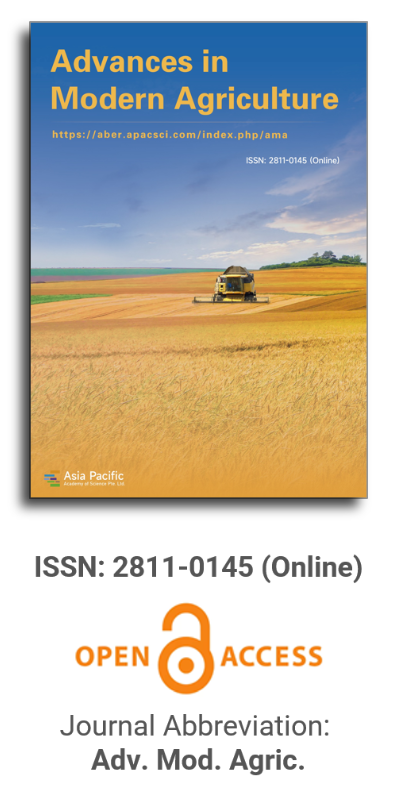


Plant genetic transformation promotes modern agriculture and the food safety of genetically modified plants
Vol 3, Issue 1, 2022
VIEWS - 5455 (Abstract)
Download PDF
Abstract
The contribution of business marketing of genetically modified (GM) plants to crop improvement, reduced use of pesticides, and the improvement of the ecological environment was presented. The toxicity and allergy of GM food, the ecological risks confronted by GM plant cultivation, and the necessity of government inspection of GM products were also discussed. GM plants and their derived products have been consumed as food for more than 30 years since the commercialization of transgenic plants in 1995. Most scientific papers have proved that there is no significant discrepancy between GM plants and non-GM plants in composition till now. The discovery of natural transgenic sweet potatoes has further demonstrated the safety of GM foods.
Keywords
References
- Kou Y, Shi L. Safety evaluation of using antibiotic resistance genes as markers in transgenic plants (Chinese). Chinese Journal of Antibiotics 2006; 31: 577–580.
- Hohn B, Levy AA, Puchta H. Elimination of selection markers from transgenic plants. Current Opinion in Biotechnology 2001; 12(2): 139–143. doi: 10.1016/S0958-1669(00)00188-9
- Ding Y, Li H, Chen LL, et al. Recent advances in genome editing using CRISPR/Cas9. Frontiers in Plant Science 2016; 7. doi: 10.3389/fpls.2016.00703
- Yu M, Li X, Gao M, et al. Establishment of CRISPR/Cas9 gene editing system for lettuce (Chinese). Plant Physiology Journal 2017; 4: 736–746.
- Chen X, Wang C, Bo R. Current status of pesticide use in China and countermeasures and suggestions (Chinese). Pesticide Science and Administration 2016; 37(2): 4–8.
- Yun J, Ma C, Feng Y, et al. Biosafety of transgenic crops: Scientific evidence (Chinese). China Biotechnology 2016; 36: 122–138.
- Nordlee JA, Taylor SL, Townsend JA, et al. Identification of a Brazil-nut allergen in transgenic soybeans. New England Journal of Medicine 1996; 334(11): 688–692. doi: 10.1056/nejm199603143341103
- Buzoianu SG, Walsh MC, Rea MC, et al. High-throughput sequence-based analysis of the intestinal microbiota of weanling pigs fed genetically modified MON810 maize expressing Bacillus thuringiensis Cry1Ab (Bt Maize) for 31 days. Applied and Environmental Microbiology 2012; 78(12): 4217–4224. doi: 10.1128/aem.00307-12
- Buzoianu SG, Walsh MC, Rea MC, et al. Transgenerational effects of feeding genetically modified maize to nulliparous sows and offspring on offspring growth and health1. Journal of Animal Science 2013; 91(1): 318–330. doi: 10.2527/jas.2012-5360
- Appenzeller LM, Malley L, MacKenzie SA, et al. Subchronic feeding study with genetically modified stacked trait lepidopteran and coleopteran resistant (DAS-Ø15Ø7-1xDAS-59122-7) maize grain in Sprague-Dawley rats. Food and Chemical Toxicology 2009; 47(7): 1512–1520. doi: 10.1016/j.fct.2009.03.041
- MacKenzie SA, Lamb I, Schmidt J, et al. Thirteen week feeding study with transgenic maize grain containing event DAS-Ø15Ø7-1 in Sprague–Dawley rats. Food and Chemical Toxicology 2007; 45(4): 551–562. doi: 10.1016/j.fct.2006.09.016
- Zhang M. On the improvement of the legal system of gene pollution isolation of transgenic crops in China (Chinese). Legality Vision 2016; 5(1): 195–196.
- Xu L, Liu P, Xiong L, et al. Identification system of agricultural genetically modified products in major countries and regions in the world (Chinese). Journal of Biosafety 2014; 23(3): 301–304.
- Chrispeels MJ. Yes indeed, most Americans do eat GMOs every day! Journal of Integrative Plant Biology 2014; 56(1): 4–6. doi: 10.1111/jipb.12147
- Moran NA, Jarvik T. Lateral transfer of genes from fungi underlies carotenoid production in aphids. Science 2010; 328(5978): 624–627. doi: 10.1126/science.1187113
- White FF, Garfinkel DJ, Huffman GA, et al. Sequences homologous to Agrobacterium rhizogenes T-DNA in the genomes of uninfected plants. Nature 1983; 301(5898): 348–350. doi: 10.1038/301348a0
- Furner IJ, Huffman GA, Amasino RM, et al. An Agrobacterium transformation in the evolution of the genus nicotiana. Nature 1986; 319(6052): 422–427. doi: 10.1038/319422a0
- Matveeva TV, Bogomaz DI, Pavlova OA, et al. Horizontal gene transfer from genus agrobacterium to the plant linaria in nature. Molecular Plant-Microbe Interactions 2012; 25(12): 1542–1551. doi: 10.1094/mpmi-07-12-0169-r
- Matveeva TV, Lutova LA. Horizontal gene transfer from Agrobacterium to plants. Frontiers in Plant Science 2014; 5. doi: 10.3389/fpls.2014.00326
- Kreuze JF, Perez A, Untiveros M, et al. Complete viral genome sequence and discovery of novel viruses by deep sequencing of small RNAs: A generic method for diagnosis, discovery and sequencing of viruses. Virology 2009; 388(1): 1–7. doi: 10.1016/j.virol.2009.03.024
- Kyndt T, Quispe D, Zhai H, et al. The genome of cultivated sweet potato contains Agrobacterium T-DNAs with expressed genes: An example of a naturally transgenic food crop. Proceedings of the National Academy of Sciences 2015; 112(18): 5844–5849. doi: 10.1073/pnas.1419685112
- Yang J, Moeinzadeh MH, Kuhl H, et al. The haplotype-resolved genome sequence of hexaploid Ipomoea batatas reveals its evolutionary history. BioRxiv 2016: 064428. doi: 10.1101/064428
- Yang J, Fan W, Wang H, et al. Recent progress in genome sequencing of sweet potato (Chinese). Plant Physiology Journal 2017; 2017(5): 768–771.
Supporting Agencies
Copyright (c) 2022 Maye Gao, Junjie Liu, Di'an Ni

This work is licensed under a Creative Commons Attribution 4.0 International License.

This site is licensed under a Creative Commons Attribution 4.0 International License (CC BY 4.0).

Prof. Zhengjun Qiu
Zhejiang University, China

Cheng Sun
Academician of World Academy of Productivity Science; Executive Chairman, World Confederation of Productivity Science China Chapter, China
Indexing & Archiving
In the realm of modern agriculture, the integration of cutting-edge technologies is revolutionizing the way we approach sustainable farming practices. A recent study published in Advances in Modern Agriculture titled "Classification of cotton water stress using convolutional neural networks and UAV-based RGB imagery" has garnered significant attention for its innovative approach to precision irrigation management. Conducted by researchers from Institute of Data Science and the AgriLife Research and Extension Center of Texas A&M University (authors's information is below). This study introduces a novel method for classifying cotton water stress using unmanned aerial vehicles (UAVs) and convolutional neural networks (CNNs), offering a powerful solution for optimizing water use in agriculture.
Modern agricultural technology is evolving rapidly, with scientists collaborating with leading agricultural enterprises to develop intelligent management practices. These practices utilize advanced systems that provide tailored fertilization and treatment options for large-scale land management.
This journal values human initiative and intelligence, and the employment of AI technologies to write papers that replace the human mind is expressly prohibited. When there is a suspicious submission that uses AI tools to quickly piece together and generate research results, the editorial board of the journal will reject the article, and all journals under the publisher's umbrella will prohibit all authors from submitting their articles.
Readers and authors are asked to exercise caution and strictly adhere to the journal's policy regarding the usage of Artificial Intelligence Generated Content (AIGC) tools.
Asia Pacific Academy of Science Pte. Ltd. (APACSCI) specializes in international journal publishing. APACSCI adopts the open access publishing model and provides an important communication bridge for academic groups whose interest fields include engineering, technology, medicine, computer, mathematics, agriculture and forestry, and environment.



.jpg)
.jpg)

.jpg)
